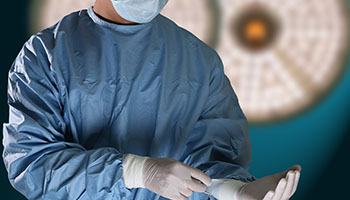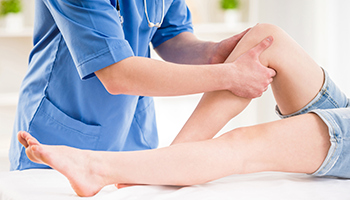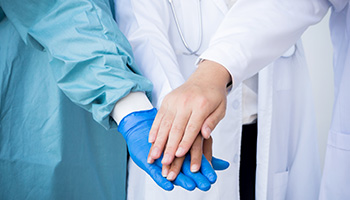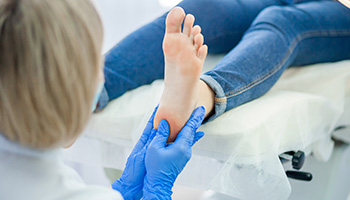Podiatry
Podiatry is the complex management of the foot and ankle involving both medical and surgical treatments. Podiatric surgery is the surgical treatment of conditions affecting the foot, ankle and lower extremities. At St. Mary’s Ambulatory Surgery Center, our podiatrist surgeons treat many diverse aspects of the foot and ankle from sports medicine, pediatrics, dermatology, and diabetes.
Heel Pain
Heel pain is pain that occurs on the back or underside of the heel. Heel pain is rarely a symptom of something more severe or complicated; however, it can interfere with everyday activities and your quality of life.
You should make an appointment if you experience any of the following:
Severe pain or swelling around your heel
Inability to bend your foot
Numbness or tingling in your heel
Severe pain following an injury to your heel
Often with rest and over the counter anti-inflammatory medications, heel pain will go away on its own. If pain is persistent or worsening, you should make an appointment to see one of our board certified podiatric physicians right away.
Bunions and Hammertoes
Bunions/ Hallus Valgus Deformity
A bunion is a boney bump on the joint of the side of the big toe. It is caused by the joint of the big toe pressing against the next toe, forcing the joint to become larger and more prominent. Over time, the joint can become painful, red, and swollen. Bunions are caused by wearing tight or inappropriate footwear, because of a structural defect in your foot, or arthritis. Bunions can also develop on the outside of the joint of the little toe, but these are less common.
Signs of a bunion include:
- A large lump at the base of your big toe joint
- Swelling, soreness, and redness in that area
- Calluses around the joint
- Pain
- Stiffness or inhibited movement of the big toe
You should see a podiatric physician if you experience:
- Severe pain
- A large bump on your big toe
- Decreased or loss of ability to move your big toe
- Difficulty finding comfortable shoes or inability to wear shoes
Hammertoes
Hammertoes are joints on the little toes that have been forced to bend at an unnatural angle. Hammertoes may allow the toe to flex or keep the toe from bending. Hammertoes are often found on women who wear high-heels, those suffering joint or nerve injury from stroke or diabetes, or people with certain medical disorders. You may notice that it is hard or painful to move the toe or you may notice thick, tough calluses and bumps forming along the toe.
If you or a loved one is experiencing any of the above symptoms from a bunion or hammertoe, make an appointment with one of our board-certified podiatric physicians today.
Ingrown/Fungus Toenails
Ingrown Toe Nails
Ingrown toe nails are very common and are characterized by a section of the toenail, usually on the big toe, that has irregularly grown into the soft tissue surrounding the nail. Ingrown toe nails can happen to anyone for a variety of reasons ranging from poor nail care to medical conditions such as diabetes.
Symptoms that your ingrown toe nail should be seen by a doctor include:
- Pain or redness around the toe nail
- Swelling of the toe, or
- If you suspect an infection
Toe nail Fungus
Toe nail fungus is a fungal infection of the toe nail or the nail bed. It can cause your toenail to turn a yellow or brown color, thicken and become ridged, or develop crumbling edges. Not only is toe nail fungus unattractive, it can also be painful and hard to cure.
If you have toenail fungus, you will want to seek the help of doctor who can prescribe medications to clear the fungus and prohibit reoccurring infections.
If you or a loved one is experiencing complications from an ingrown toe nail or toe nail fungus, you should see a podiatric doctor soon.
Diabetic Foot Care
For people with diabetes, foot care is important. Proper diabetic foot care can help to prevent many serious issues often suffered by those living with diabetes.
Risks and complications include:
High blood sugar – which can cause nerve damage in the feet, resulting in reduce feeling (neuropathy), which makes it hard to notice injuries or damage to the foot. High blood sugar can also cause dry, cracked skin, increasing risk for infection.
Narrow blood vessels – causing reduced blood flow to the feet, contributing to the slow healing of sores, wounds, and injuries.
The following steps can be taken to help prevent common diabetic foot issues:
- Look closely at your feet and examine them each day
- Keep your feet clean and dry
- Moisturize your feet daily to help combat dry, cracked skin
- Trim toenails straight across to reduce instances of ingrown toe nails, which can lead to infection.
- Protect your feet with proper shoes and socks to reduce likelihood of injuries
Diabetic Shoes
An important part of diabetic foot care is wearing proper shoes. Shoes for diabetics are often designed and made from materials that are soft and accommodate common conditions suffered by persons with diabetes such as neuropathy, poor circulation, and even deformities of the foot and ankle, including hammertoes and bunions. With appropriate footwear, some problems can even be prevented.
A Podiatric physician will examine the foot and note any concerns or developing issues, which may result in the physician recommending custom-made diabetic shoes. The podiatric physicians with PMPTX are specially trained to recognize and treat the diabetic foot, including prescription of custom-made orthotics and footwear.
Managing your diabetes under the care of your primary doctor, along with regular foot care from a podiatric physician can help prevent many diabetic foot problems and potentially save your feet. If you or a loved one has diabetes it’s critical to your feet and your over-all health to have a Board Certified Podiatric physician examine and care for your feet on a regular basis.
Athletic Injuries
Ankle Sprains
Athletic or sports related tendon injuries are common in the feet and ankles. Running, twisting the foot and ankle, and hard impacts are most often to blame. Common injuries range from twisted or sprained ankles, stress fractures or brakes in the bones of the foot, and Achilles injuries.
Ankle sprains and breaks are the result of injury that occurs when the ankle rolls, turns, or twists in an unnatural way. This motion is usually abrupt and can cause a popping feeling or sound as the ligaments, which are like bands that hold the bones together, stretch or rip as the ankle bones fracture.
Stress Fractures
Stress fractures and shin splints are brakes in the bones of the feet, ankles, or shins. These are often small, hairline fractures that are caused by repeated impact. Runners often get stress fractures on the tops of their feet where shoe laces put pressure on the bones. Runners are not the only people to experience stress fractures as they can occur anywhere in the foot or ankle for a variety of reasons, sometimes related to soft bones as we age or improper footwear.
Achilles Injuries
An injury to the Achilles tendon is often classified as Achilles tendonitis and is caused by an overuse of a band of tight tissue that connects the muscle at the back of the leg to the bone of the heel. Achilles injuries are most often seen in long-distance runners or those increasing the duration and intensity of their runs due to training.
Ankle Dislocation
Ankle dislocation is a result of high-impact trauma that affects the tendons in the ankle. Dislocation is often a result of car accidents or sports injuries from jumping actions. The force of the impact forces or stretches the ankle into an unnatural position.
Your feet are probably the most over-looked part of your body. As you exercise or participate in sports, pay close attention to what your feet and ankles are telling you.
Flat Feet/Falling Arches
Flat feet are common, especially for infants and young children. Flat feet can also be normal in adults who never developed arches. However, in some people, the arch has fallen from its original, higher position. This can be because of wear and tear that can weaken the tendon that runs along the inside of the ankle that supports the arch.
Causes of falling arches include:
- Obesity
- Injury to your foot or ankle
- Rheumatoid arthritis
- Aging
If you’re not experiencing pain from your fallen arches, it is possible to live without any complications. However, if you have pain of any kind, or if it is worsening over time, it’s important to see a doctor.
Skin Problems
Athlete’s foot
Athlete’s foot is a skin disease caused by a fungus that usually occurs between the toes. The fungus attacks the feet because shoes create a warm, dark, and humid environment that encourages fungus growth. Warm, damp areas around swimming pools, showers, and locker rooms are also breeding grounds for fungi.
Symptoms of athlete’s foot include drying skin, itching, scaling, inflammation, and blisters on and between the toes. Athlete’s foot can spread which is why it’s important to treat properly and immediately.
If you or a loved one is experiencing any of these issues and symptoms, it’s important to have a board-certified podiatrist examine the feet to diagnose and prescribe treatment.
Blisters
Blisters on the feet are caused by friction and do not require medical attention. New skin will form underneath the affected area and the fluid built up in the blister is simply absorbed back into the tissue. You can soothe ordinary blisters with vitamin E oil or aloe-based cream. If you do need to pop a blister, do so with a clean needle and remember to seek medical care if the liquid is yellow or has an odor.
You can prevent blisters by using a wax-based balm or petroleum jelly on the affected area before putting on socks and shoes. Wear proper fitting socks and be sure to wash and dry your feet daily to avoid infections.
If you or a loved one is experiencing any of these issues and symptoms, it’s important to have a board-certified podiatrist examine the feet to diagnose and prescribe treatment.
Burning Feet
This is a condition that is most common with adults over age 50 or those with long-term diabetes. Thyroid dysfunction, gastric restriction in morbidly obese people, and heavy use of alcohol have also been linked with burning feet. Nerve problems, such as neuromas may also be associated with the sensation of burning feet.
Here are some ways to deal with the discomfort:
- Make sure you wear shoes that fit properly and provide support for your unique foot structure
- Take foot baths daily to treat hot and sweaty feet
- Wear cotton socks
- Avoid long periods of standing
- Try cushioned or shock-absorbing insoles in your shoes to make standing more comfortable
- In some cases, orthotics may be helpful to correct any underlying mechanical problems
If you or a loved one is experiencing any of these issues and symptoms, it’s important to have a board-certified podiatrist examine the feet to diagnose and prescribe treatment.
Calluses
A callus is a hard area of built-up skin that is the result of repeated pressure or friction over time. Although considered a skin condition, calluses are actually a problem associated with the bones in the feet and ankles. Calluses can range from unsightly and annoying to very painful.
PMPT recommends the following to prevent and treat calluses:
Switch to a well-fitting shoe or use orthotics to create a better environment for your foot.
Buy socks with reinforced heels and toes and wear nylon pantyhose with woven cotton soles on the bottom of the feet.
To treat calluses, try an over the counter acid-based callus remover product or try soaking the callus to soften the tough skin and relieve pain.
If you or a loved one is experiencing any of these issues and symptoms, it’s important to have a board-certified podiatrist examine the feet to diagnose and prescribe treatment.
Corns
Corns are calluses that form on the toes because of bones that push up against shoes and build up pressure on the skin. The surface layer of the skin thickens, irritating the tissues underneath. Hard corns are usually located on the top of the toe or on the side of the small toes. Soft corns resemble open sores and develop between the toes as they rub against each other.
Improperly fitting shoes are the leading cause of corns. Toe deformities, such as hammertoe or claw toe, can also lead to corns. Self-care for corns includes soaking feet regularly and using a pumice stone or a callus file to reduce the size of the corn. Special over-the-counter, non-medicated, donut-shaped foam pads can be worn to help relieve the pressure and discomfort.
If you or a loved one is experiencing any of these issues and symptoms, it’s important to have a board-certified podiatrist examine the feet to diagnose and prescribe treatment.
Cysts
Cysts are fluid-filled masses located under the skin, in the tendons in the foot and ankle, or on bone. Many cysts eventually become painful, especially if they are located in the tendons or if they grow and press on a nerve.
PMPT recommends the following steps to help prevent and treat cysts:
- Wear proper fitting shoes
- Avoid repeated foot injuries or injuries left untreated
- Some persistent types of cysts can be treated simply by numbing the area and then using a needle to remove fluid from the cyst. A steroid or hardening agent may then be injected into the cyst to prevent it from again filling with fluid.
Frostbite
Extreme exposure of your feet to cold for a prolonged period can lead to a serious condition called frostbite. Frostbite starts by producing pain and a burning sensation in the exposed areas. This is followed by numbness in toes or feet and changes in skin color, from pale or red to bluish-gray or black. People with a history of frostbite often get it in again in the same place.
Frostbite can affect only the skin and underlying tissue or be as severe as to affect deeper parts of the foot and ankle, such as the muscle, tendons, nerves, and bones. The extent of the injury impacts the prognosis for healing and long-term complications.
Children, the elderly, and diabetics are most susceptible to frostbite because of those group generally have poor circulation in the lower extremities.
If you or a loved one is experiencing any of these issues and symptoms, it’s important to have a board-certified podiatrist examine the feet to diagnose and prescribe treatment.
Gangrene
Gangrene is caused by loss of blood supply to the foot and ankle or by a bacterial infection as a result of open sores or ulcers. Diabetics are most prone to gangrene because they typically have poor circulation or nerve damage, which can lead to loss of blood supply. Any sudden onset of foot or leg pain accompanied by lower skin temperature and skin color changes may indicate a sudden blockage of blood flow to the legs.
If you or a loved one is experiencing any of these issues and symptoms, it’s important to have a board-certified podiatrist examine the feet to diagnose and prescribe treatment.
Lesions
Skin lesions refer to any variation in skin color or texture anywhere on the body. Some skin lesions are present at birth, such as moles, freckles, or birthmarks. Others are acquired over time, such as warts, allergies, sunburn or abrasions. Most skin lesions are harmless. However, it is important to keep an eye on them because they can change over time, which may be a sign of a more serious condition, like cancer. Skin biopsies are easily taken of any suspicious lesion at chairside under local anesthesia. The specimens are then sent to a pathologist for evaluation. A report is generated explaining what the lesion is and treatments can be considered.
If you or a loved one is experiencing any of these issues and symptoms, it’s important to have a board-certified podiatrist examine the feet to diagnose and prescribe treatment.
Psoriasis
Psoriasis is a common, chronic, and recurrent inflammatory disease of the skin characterized by round, reddish, dry, and scaly patches covered by grayish-white or silvery-white scales. Lesions from psoriasis are sometimes found on the feet and ankles and can be difficult to distinguish from Athlete’s foot or a fungal infection of the toenail.
If you or a loved one is experiencing any of these issues and symptoms, it’s important to have a board-certified podiatrist examine the feet to diagnose and prescribe treatment.
Foot Odor
The feet contain more sweat glands than any other part of the body and because of all those sweat glands, foot odor can be a big (and embarrassing) problem. Foot odor mainly occurs for two reasons: foot sweat and choice of footwear. The interaction between the perspiration and the bacteria that thrive in shoes and socks generates the odor.
Treating foot odor can be as simple as selecting different shoes, socks, or using a talc-based foot powder to reduce moisture. PMPT recommends an evaluation so proper diagnosis can be determined.
If you or a loved one is experiencing any of these issues and symptoms, it’s important to have a board-certified podiatrist examine the feet to diagnose and prescribe treatment.
Swelling
Swelling of the feet is also called edema. It is often caused by an abnormal build-up of fluids in the ankle and leg tissues. Painless swelling of the feet and ankles is a common problem, particularly in older people. It may affect both feet and ankles or just one side. However swelling in the feet and ankles can be a symptom of something more serious such as heart failure, renal failure, or liver failure.
If your swelling is not due to an underlying health issue, you can reduce swelling by elevating your legs while lying down. Avoid sitting or standing without moving for prolonged periods of time. Avoid putting anything directly under the knees when lying down, and don’t wear constricting clothing on the upper legs.
If you or a loved one is experiencing any of these issues and symptoms, it’s important to have a board-certified podiatrist examine the feet to diagnose and prescribe treatment.
Ulcers
Ulcers are wounds on the skin that are slow to heal. The ball of the foot is most the most common area because of the greater amount of pressure experienced in that location. Over time, the skin becomes thick and calluses form, which leads to pockets of fluid, infection, and ulcers.
If you or a loved one is experiencing any of these issues and symptoms, it’s important to have a board-certified podiatrist examine the feet to diagnose and prescribe treatment.
Neuroma/Warts
Neuroma
A neuroma is a painful condition in the ball of your foot, usually between the third and fourth toes, and may create the feeling of standing with a rock in your shoe. The type of shoe a person wears is often linked to a neuroma. Women who wear high-heels have higher instances of suffering from this condition. Besides the sensation of standing on a rock, a neuroma can cause burning pain in the ball of your foot that moves into your toes, or tingling and numbness in your toes.
Other causes of neuroma are trauma caused by sports injuries or repetitive movements, and foot deformities.
If you or a loved one is experiencing any of these issues and symptoms, it’s important to have a board-certified podiatrist examine the feet to diagnose and prescribe treatment.
Warts
Warts are hard non-cancerous growths. Warts on the foot are called Plantar Warts and are the result of the Human Papillomavirus (HPV). Plantar Warts are generally found on the ball or heel of the foot. Most of the time, there is nothing to worry about when you have a Plantar Wart and you may find relief from over-the-counter medications. However, if you experience pain or if the wart doesn’t go away with treatment, you will want to make an appointment to see your doctor.
Your Feet and Toes
The foot is a complex and unique structure. It is made up of 26 bones, 33 joints, 107 ligaments, 19 muscles, and numerous tendons. Complex biomechanics keep all these parts in the right position and moving together. Given these intricacies, it is not surprising that most people will experience some problem with their feet at some time in their lives.
When people experience problems with their feet, like any part of the body, it often affects daily activities and quality of life. Women who wear high heel shoes, athletes, and diabetics need to pay close attention to the health of their feet.
PMPT recommends the following foot care guidelines:
- Don’t ignore foot pain.
- Keep your feet clean and free of moisture throughout the day.
- Trim toenails to help prevent ingrown nails and infections.
- Make sure you have proper-fitting shoes and don’t wear the same pair every day and purchase new shoes later in the day when your feet are swollen to ensure proper fit.
- Be cautious of self-diagnosis and home treatment and remedies for foot conditions.
Many of us know the importance of exercising our bodies – but we don’t often think about the importance of exercising our toes! Here are some beneficial toe exercises you can do every day:
Toe raise, toe point, toe curl – Hold each position for 5 seconds and repeat 10 times. This is recommended for people with hammertoes or toe cramps.
Toe squeeze
Place a small, cylindrical object, such as a wine cork, between your toes and hold a squeeze for 5 seconds. Do this 10 times. This is recommended for people with bunions or toe cramps.
Big toe pulls
Place a thick rubber band around the big toes and pull them away from each other and toward the small toes. Hold for 5 seconds and repeat 10 times. Recommended for people with bunions or toe cramps.
Toe pulls
Put a thick rubber band around all for your toes and spread them. Hold this position for 5 seconds and repeat 10 times. This is especially good for people with bunions, hammertoes, or toe cramps.
Take some time and do a foot and toe self-exam. Make notes of problems, irregularities, or pain that you experience. Nobody should have to live with foot pain and disorders.
Your Ankles
The ankle is made up of two joints and three bones. It is a very complex structure. This part of the foot and ankle is responsible for the up and down and side to side movements of the foot, without which, we wouldn’t be able to walk, ride a bike, or drive a car – many of the actions we perform each day.
Ankle pain can develop after injury or as a result of a chronic condition, such as arthritis. Signs of ankle problems can be any of the following:
- Ankle weakness and instability
- Difficulty or pain when walking
- Pain on the outer side of the ankle
- Arthritis in the ankle
- Stiffness, swelling and tenderness
- If you suffer repeated ankle sprains, and
- Wear well-structured and proper fitting shoes
Sometimes conditions and injuries are unpreventable. However, there are things you can do to minimize the risk of ankle injury. In order to help keep your ankles healthy PMPT recommends the following:
- Strengthen your ankles with exercise like walking and flexing the foot up and down
- Stretch the muscles around your ankle before and after activity
- Examine your ankles and be aware of any pain, discomfort, or changes
Make note of problems, irregularities, or pain that you experience. Nobody should have to live with foot and ankle disorders.
Shoes and Orthotics
Heel Pain
Heel pain is pain that occurs on the back or underside of the heel. Heel pain is rarely a symptom of something more severe or complicated; however, it can interfere with everyday activities and your quality of life.
You should make an appointment if you experience any of the following:
Severe pain or swelling around your heel
Inability to bend your foot
Numbness or tingling in your heel
Severe pain following an injury to your heel
Often with rest and over the counter anti-inflammatory medications, heel pain will go away on its own. If pain is persistent or worsening, you should make an appointment to see one of our board certified podiatric physicians right away.
Specialties & Services
We focus on offering a high quality, service-oriented environment for your surgical procedure. Our mission is to care for every patient and their family as if they were our own. Each patient, each family, each and every time.
Interested in Outpatient
Joint Replacement?
Click the button below to learn more about Outpatient Joint Replacement at St. Mary’s Ambulatory Surgery Center.






